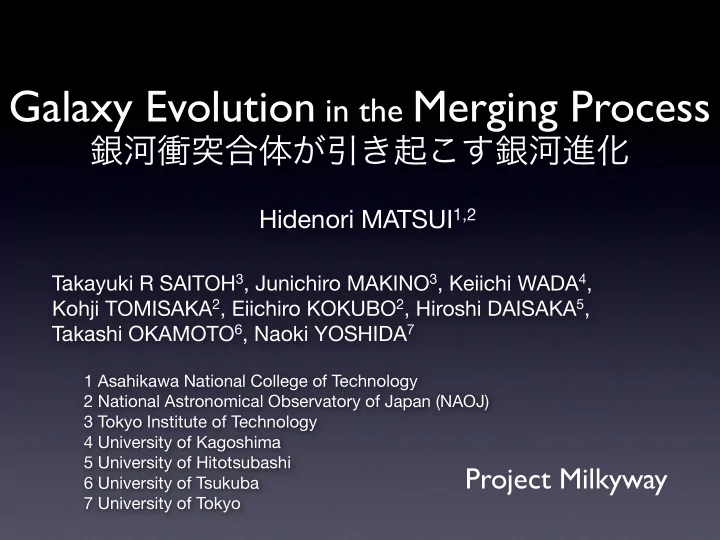

銀河衝突合体が引き起こす銀河進化 Galaxy Evolution in the Merging Process Hidenori MATSUI 1,2 Takayuki R SAITOH 3 , Junichiro MAKINO 3 , Keiichi WADA 4 , Kohji TOMISAKA 2 , Eiichiro KOKUBO 2 , Hiroshi DAISAKA 5 , Takashi OKAMOTO 6 , Naoki YOSHIDA 7 1 Asahikawa National College of Technology 2 National Astronomical Observatory of Japan (NAOJ) 3 Tokyo Institute of Technology 4 University of Kagoshima 5 University of Hitotsubashi Project Milkyway 6 University of Tsukuba 7 University of Tokyo
The role of the Galaxy Merger • Galaxy-Galaxy merging triggers galaxy evolution dramatically. • Active star/star cluster formation (Mengel+2008) • Disk galaxies → Elliptical galaxies • Evolution of the galactic central region • Fueling of gas (Barnes & Hernquist 1996, Kazantizidis +2005) Marconi & Hunt 2003 • Coevolution of supermassive black hole and galactic bulge Mengel+ 2008 Galaxy-Galaxy merging is important process for galaxy evolution.
Previous Numerical Simulations (e.g., Barnes & Hernquist 1996) • SPH method • Problems Antennae • limited resolution M SPH ∼ 10 5 − 6 M ⊙ ǫ ≥ 100 pc • Interstellar Medium (ISM) model • isothermal gas (T=10 4 K) or radiative cooling (T>10 4 K) • star formation d ρ ∗ ρ gas d t = C ∗ t dyn ➡ These simulations cannot reproduce characteristic Active star formation structures (shock-induced starburst and star cluster formations) observed in merging galaxies. Mihos & Hernquist 1992 ➡ The behavior of ISM might be completely different from that of actual merging galaxies.
High Resolution Simulations of Merging Galaxies (Saitoh et al. 2009) • Simulation code “ASURA” star formation • Tree+GRAPE Nbody/SPH • resolution M SPH ∼ 10 3 − 4 M ⊙ ǫ = 20 pc • radiative cooling (10 K<T<10 8 K) • heating from Type II supernovae star formation • star formation (T<100 K, ) n H > 100 cm − 3 Previous simulations Simulation (Saitoh+2009)
Results of Saitoh et al. 2009 The behavior of ISM is very different from that of previous simulations. ➡ High resolution simulations with multi-phase ISM model are essential to understand galactic evolution in the merging process.
Our simulations(Method) • ASURA code (Saitoh et al. 2008) • particle numbers • SPH 510,000 , old stars 1,800,000 , DM 28,000,000 • mass/spatial resolutions M SPH = 7 × 10 3 M ⊙ • radiative cooling (10 K < T < 10 8 K) ǫ = 5 , 20 pc • heating from TypeII supernovae • star formation (T<100 K, ) n H > 100 cm − 3 • using various collision geometries
Simulation Models Disk(gas + old stars) M disk ∼ 10 10 M ⊙ Disk(gas + old stars) M gas ∼ 10 9 M ⊙ exponential disk Dark halo(Dark matter) M DM ∼ 10 11 M ⊙
Collision Geometries Orbit : Parabolic Inclination of disks z ω R peri y i x orbital plane R peri (kpc) i 1 i 2 ω 1 ω 2 tilt/tilt 7.5 -109 -30 71 -30
Results 1. Formation of Hypermassive Star Clusters 2. Origin of Multiple Nuclei 3. Mass supply to the galactic central region
Results 1. Formation of Hypermassive Star Clusters 2. Origin of Multiple Nuclei 3. Mass supply to the galactic central region
Formation of Hypermassive Star Clusters Distribution of newly formed stars • Mass of star clusters 1 . 7 × 10 8 M ⊙ 1. 1 . 3 × 10 8 M ⊙ 2. 6 . 9 × 10 7 M ⊙ 3.
Results 1. Formation of Hypermassive Star Clusters 2. Origin of Multiple Nuclei 3. Mass supply to the galactic central region
ULIRGs with multiple nuclei @ z~0.1 (Borne+2000, Cui+2001) • ULIRGs • L(8 μ m-1000 μ m) > 10 12 L ⊙ • Observation of ULIRGs@z~0.1 by HST I-band Absolute Magnitude of core M I < -17 (Cui et al. 2001) Borne et al. 2000 20% (<80%) of the samples have multiple nuclei.
Our simulation data + PEAGSE (I-band) • Absolute Magnitude (I-band ) 950 Myr 1. -17.6 2. -17.2 2 3. -16.4 1 3 10 kpc Galaxies with multiple nuclei are explainable in a single major merger.
Results 1. Formation of Hypermassive Star Clusters 2. Origin of Multiple Nuclei 3. Mass supply to the galactic central region
Mass Supply to Galactic Central Region ε =20 pc Mass evolution (<100 pc) second encounter
Density Profile DM+Baryon Matsui+ in prep Kazantzidis+2005
Summary • We have performed high resolution simulations of merging galaxies. • Hypermassive star clusters form in the merging process. • Galaxies with multiple nuclei are explainable in a single major merger. • Mass supply (< 100 pc) takes place in merging process.
Recommend
More recommend